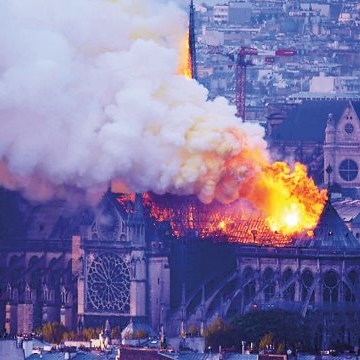
World

The Jewish icons of Notre Dame
JORDAN MOSHE
While the Christian world is reeling over the damage to a site of such religious significance, Jews have also acknowledged the significance of this catastrophe.
“We are all in shock, believers and non-believers, Christians and non-Christians, because a jewel of the history of France and Christianity as much as of the heritage of Europe is currently in flames,” said Joel Mergui, the president of the Consistoire Central Israélite de France, the organisation responsible for the religious affairs of French Jews.
Dating back to the 12th century, Notre Dame features elaborate architecture including friezes, statues, and stained-glass windows that illustrate religious stories for the edification of the Christians of medieval Paris. The few Jewish figures among them depict Christianity’s conflicting, often antagonistic attitudes toward Jews throughout history. For better and for worse, they reflect the vicissitudes of Jewish history in France.
The Catholic Church, which commissioned the cathedral, was also behind the famous Paris controversy in which the Talmud was tried for blasphemy against the church in 1240. The trial ended with a decree issued from Notre Dame Cathedral that ordered the seizure of all copies of the Talmud, numbering about 10 000 handwritten volumes, and their burning.
French King “Saint” Louis IX (1214-1217) was not a friend of the Jews. His hatred of Jews led to forced conversions, the final crusades, and massacres of Jews.
However, the architecture of the building itself suggests a far more complex relationship between the two faiths, according to some experts.
A raised carving of two individuals surmounts the cathedral’s main entrance, and although they are recognised Christian saints, these individuals were in fact Jewish. They are Anne and Joachim, thought to be the grandparents of Jesus. Represented in various settings across different friezes, these two figures offer us a unique glimpse of the Jewish past.
A frieze depicting their wedding is set in a seemingly faithful reproduction of a medieval French shul, complete with a rabbi wrapped in a tallit, an ark containing a Torah, and a ner tamid (eternal flame). Another shows them bringing an offering, and two medieval Jewish figures are deep in conversation close by.
Thanks to these depictions, we know what Jews in Paris wore because they have adorned Notre Dame for 800 years: long robes and tall pointy hats. This was the historically mandated dress code for Jews in the 13th century.
Even the figures of Anne and Joachim themselves are based on actual local Jews who were alive at the time, used by the artist as models.
On another surface, Notre Dame displays the figures of Ecclesia and Synagoga, two female figures who personify the Church and the Jewish religion. Synagoga is depicted as plain, defeated, and blindfolded, suggesting Judaism’s irrelevance. Meanwhile, Ecclesia is majestic, and often wears a crown and Christian symbols.
Although Synagoga was seen as plain here, much like many traditional depictions, she is also cast in Notre Dame as an uncommonly elegant, graceful woman, with an almost aristocratic appearance. Rather than an anti-Semitic depiction, and though she has not accepted the truth of Christianity, she remains dignified, seemingly an acknowledgment of the standing of the Jewish faith, effectively the mother faith of Christianity.
The interior of the cathedral further illustrates this puzzling relationship. A plaque inside honours Aaron Lustiger, a Paris-born Jew of Polish origin who, when his family was threatened by Nazi persecution, converted to Catholicism at the age of 13. Lustiger’s mother was murdered in Auschwitz. After the war, his father tried to have the baptism annulled, but not even the chief rabbi of Paris could change it. Renamed Jean-Marie Lustiger, he entered a seminary and eventually became Archbishop of Paris. Lustiger continued to consider himself Jewish in spite of his conversion, and in fact recited kaddish for his mother in shul after her death.
Christian though the building may be, Jews are inextricably bound up in its history, and continue to be drawn into its orbit.
Although French police are treating the fire as an accident, several conspiracy theorists took to social media to blame Jews. Some blamed the Rothschilds on the grounds that French President Emanuel Macron once worked at a Rothschild-owned bank. Others accused Jews of wanting to destroy Christianity.
So, whether you believe that Jews have nothing to mourn over, or that they have lost something of historical significance, the fact is that Notre Dame is more than a Christian cathedral; it is a significant part of Jewish history.




